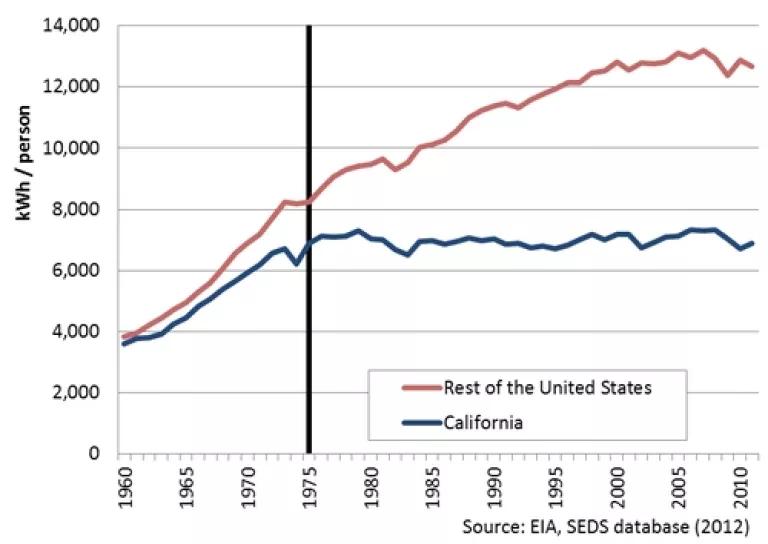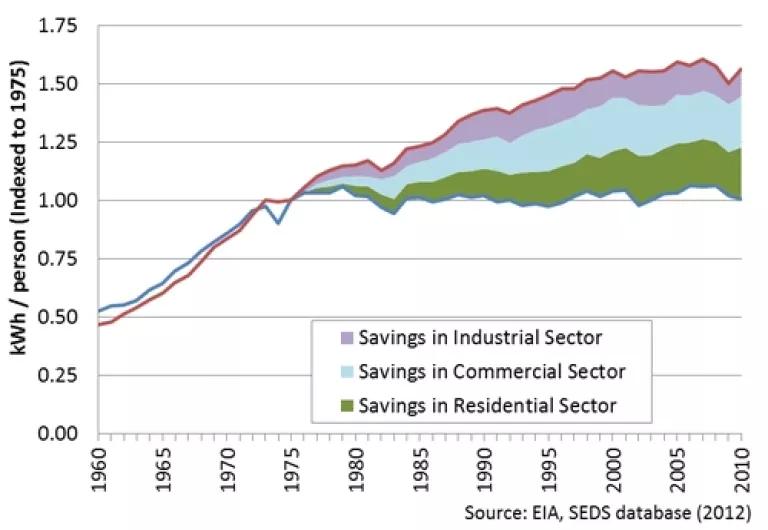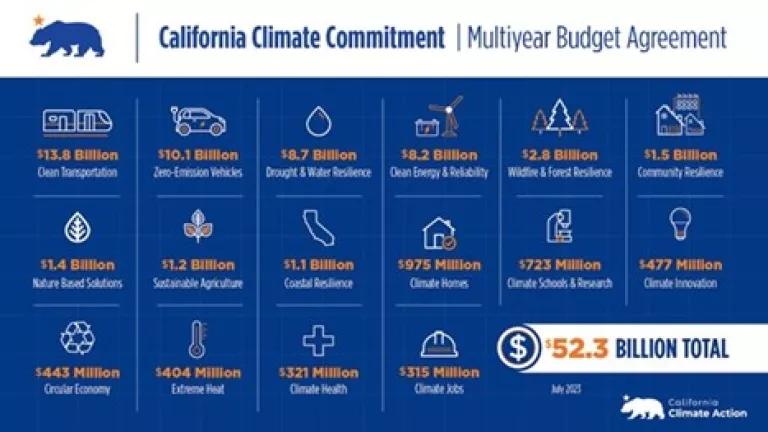Although some naysayers question whether efficiency policies alter the amount of energy people actually use, there is no doubt that strong policies embracing this cheap and clean energy resource help keep the lights on and lead to major reductions in energy consumption.
This was underscored this week with the release of a national bipartisan report citing energy efficiency’s continuing and huge potential as a major U.S. resource, and the mammoth savings achieved over the past four decades that can be credited to efficiency programs.
One of the classic examples is the Rosenfeld Curve which famously shows that California – a leader in energy efficiency policies – has kept per capita electricity consumption nearly flat over the last 40 years while usage by the rest of the nation increased by over 50 percent.
Rosenfeld Curve: Per Capita Electricity Consumption in California and the U.S.

California first pioneered new energy efficiency policies in the 1970s and since then, the state’s per capita electricity consumption has taken a starkly different path than the rest of the nation. Californians have saved over $65 billion and avoided at least 30 power plants due to investment in research and development of more efficient technologies, utility programs that help customers use those technologies to lower their bills, and minimum energy-savings standards for new buildings and appliances.
Yet some critics incorrectly claim California would have reduced its electricity consumption without efficiency policies. This belief that “everything would have happened anyway” has led to a number of myths about the Rosenfeld Curve (named for Dr. Arthur Rosenfeld, one of the “fathers” of energy efficiency and recent recipient of the National Medal of Technology and Innovation).
Myth #1: Decline in Industry
Some contend the flat consumption in the Rosenfeld Curve is simply due to heavy industry leaving California. But heavy industry was leaving the entire country, not just California, during that period. Therefore, the difference between California and the rest of the nation cannot fully be explained by something that was happening in both locations.
Much of the gap between California and the rest of the country is actually due to changes in the residential and commercial sectors, which each account for about 40 percent of the difference. The variance in industrial electricity consumption represents only a small portion (the remaining 20 percent) and California has a long history of industrial efficiency programs that help explain that gap.
Rosenfeld Curve with Per-Capita Electricity Savings Allocated by Sector

Myth #2: California Sunshine
Some argue the flat consumption is due to California’s weather. But California has enjoyed good weather since the beginning of time. Therefore, the widening gap between the state’s electricity use and the rest of the nation cannot be explained by something that has always existed.
Furthermore, weather-driven electricity consumption is largely due to air conditioning (since heating needs in California and much of the nation are largely satisfied by other fuels). So California’s mild winters aren’t a significant factor in the Rosenfeld Curve. As for the summers, most of the state’s population increasingly lives in Southern California and the Central Valley, which have hot summers and significant air conditioning loads.
Looking at trends in total household per capita energy consumption (including both electricity and home heating fuels, and adjusted for year-to-year weather variations) shows California has far outstripped every other state in making continuous efficiency progress.
Number of 10-year Periods with Declining Weather-adjusted Per Capita Residential Energy Consumption (1985-2010)

Source: ACEEE
Myth #3: High Prices
Perhaps the embodiment of the “everything would have happened anyway” philosophy is the myth that California’s high prices caused all the energy savings. Research has shown that demand for electricity is actually very insensitive to price. Moreover, most consumers don’t even know the price of their electricity, per kilowatt hour, because it is buried in complicated utility bills. They do know, however, the size of the check they write to their utility every month. And California households’ monthly electric bills are 25% below the national average.
Higher rates help make energy efficiency investments more cost-effective for consumers, but decades of research and experience show that on their own, consumers leave even highly cost-effective efficiency opportunities untapped due to a number of market barriers. For example, a homeowner rushing to replace a broken clothes washer might not find efficient options available at the local store, know about the relative efficiencies of different models, or have the capital to pay for the higher upfront cost of a more efficient machine even though the energy savings over time would pay it back.
This is where state and federal efficiency policies and programs can break down the barriers to enable customers to upgrade their efficiency and lower their utility bills. Energy prices are part of the equation, but prices alone won’t get the job done when it comes to energy efficiency.
Energy Efficiency Policies Work
There have been other attempts to explain away the Rosenfeld Curve, and although a portion of it can be explained by factors that are independent of energy policy (such as types of industry and average household size), the truth -- simple as it may be -- is that efficiency policies that roll out more energy-saving technologies end up saving energy.
And while that might not make headlines, innovative policies and programs have led to significant reductions in both Californians’ energy bills and energy usage—and will continue to do so. The rest of the nation could do the same.
And that’s no myth.



